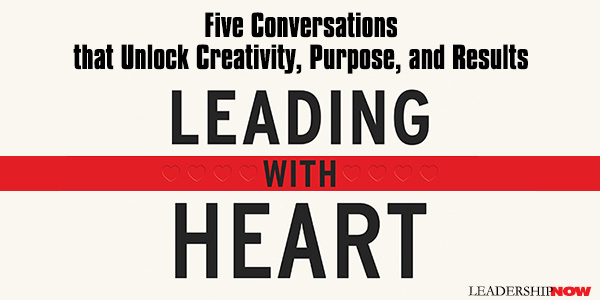 |
 |
07.18.22

Leading with Heart: Five Conversations that Unlock Creativity, Purpose, and Results
THERE ARE FIVE core characteristics that help leaders connect at an authentic human level with their people: they are aware of other people’s needs, they confront their people’s fears, they understand their own desires and what drives their people, they leverage their gifts, and they connect with purpose. These leaders lead with heart. They are “simply the most relentlessly curious, caring, and insightful about themselves and their people.” John Baird and Edward Sullivan explain in Leading with Heart that they do it by engaging in conversations about what we really need to feel safe and creative. The five questions are designed to remove the barriers that have kept us from leading with heart: 1. What do you need to be at your best? When a houseplant wilts, we don’t yell at it, offer it more money, or put it on a performance improvement plan. We give it more water, move it closer to the sun, and make sure it’s getting the nutrients it needs until the leaves perk up and regain their color. The same goes for us as people. To lead with heart means we need to have conversations about not only our physical (diet, sleep, and exercise) and emotional needs but also the physical space we function in—the environment. Often our belief systems keep us from doing what we should be doing to be sure our baseline needs are being met. And then we ac out. “Some clear tells that we ourselves ou our teams are not getting their needs met: irritability, disagreements, anxiety, lack of motivation, and lack of creativity, all of which make us susceptible to being triggered into fear responses.” 2. Which fears are holding you back? We create negative or self-limiting stories about ourselves. By uncovering what frightens us and by getting radically serious about the fears of our teams, we can begin ridding ourselves of blocks, untruths, and old defeatist stories that weigh on us, as well as all the unhelpful behaviors we engage in when we are triggered in response to our fears. What are my fears is the most challenging conversation to have and to create change around. Naming your fear(s) and embracing them in order to choose different behaviors is the first step. People around us are acting out of fear all the time. Compassion and curiosity for that fear are your first line of defense. 3. Which desires drive you, and which might derail you? Our deepest desires can be incredible sources of motivation. Feeling like we are winning, like we are contributing, like we have influence—these can get us out of bed in the morning. But if we let our desires get out of hand, we can get derailed. Leaders who fall from grace most often have a desire problem because they satisfy a short-term desire without considering the long-term consequences. We can create blindspots around our desires as we rationalize what feels good to us. It is crucial for leaders to be very clear about what their values mean in practice. Transparency can be conflated with having no privacy. Honesty can be conflated with oversharing. And inclusion can be conflated with consensus. 4. What are your greatest gifts? The greatest leaders have an uncanny ability to find the unrecognized gifts in their people. They see past what people think they are good at and find something instead that they are great at. Our gifts sometimes come from curious places. From our grief, our flaws, and even our darkest moments. Sometimes our flaws are the overuse of our gifts. When a gift is overused, we and those around us fail to derive the potential that is there to contribute. You will find your gifts and superpowers in your painful experiences. “Many of the most successful and impactful adults had childhoods that were compromised in some way by neglect or abuse. The first step in claiming the gifts we derive from painful experiences is to reframe the stories we tell ourselves about those experiences.” Leading with heart includes helping people see their own gifts and expand their sense of what they are capable of. Social scientists have been telling us for years that positive reinforcement is the best way to get others to adopt new behaviors. Yes, we really are just waiting for someone to say, ‘Good job!’” 5. What is your purpose? Conversations around purpose are really about what impact we seek to have on the world. What am I (or we) here to do? Who am I (or are we) here to serve? Conversations around purpose are perhaps the most important because while we have conversations about our needs, fears, desires, and gifts, if we don’t have a clear sense of purpose, “we don’t have a place to put all that clarity and energy.” Someone who is living without their critical needs being met is often not able to make space in their life for service to others, which is what finding your purpose is all about. These five conversations become your organizational culture. Your culture is a “manifestation of how you as an organization help each other see and understand your needs, fears, desires, gifts, and purpose.

Posted by Michael McKinney at 01:32 PM
|
BUILD YOUR KNOWLEDGE
 

How to Do Your Start-Up Right STRAIGHT TALK FOR START-UPS 
Grow Your Leadership Skills NEW AND UPCOMING LEADERSHIP BOOKS 
Leadership Minute BITE-SIZE CONCEPTS YOU CAN CHEW ON 
Classic Leadership Books BOOKS TO READ BEFORE YOU LEAD |